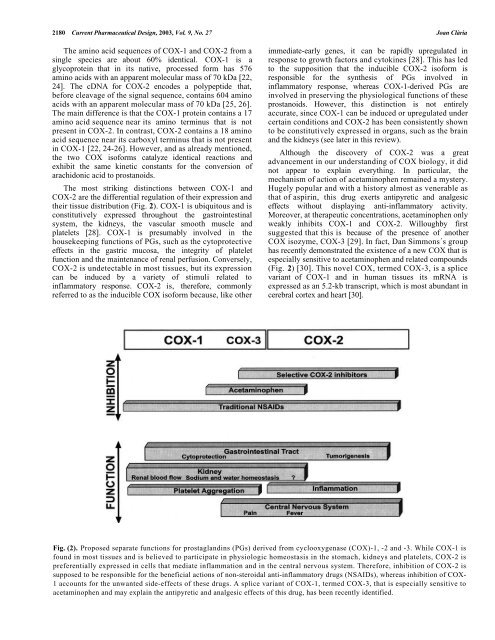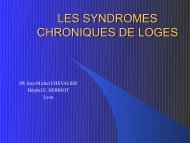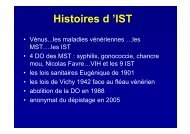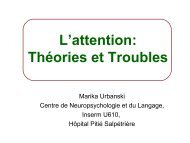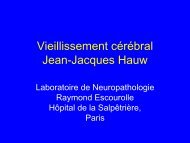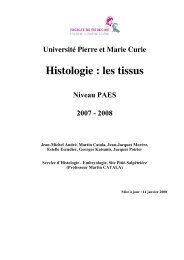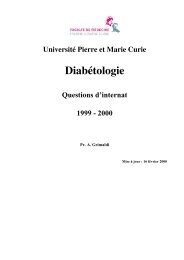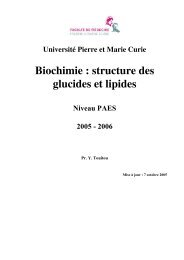Cyclooxygenase-2 Biology
Cyclooxygenase-2 Biology
Cyclooxygenase-2 Biology
You also want an ePaper? Increase the reach of your titles
YUMPU automatically turns print PDFs into web optimized ePapers that Google loves.
2180 Current Pharmaceutical Design, 2003, Vol. 9, No. 27 Joan Clària<br />
The amino acid sequences of COX-1 and COX-2 from a<br />
single species are about 60% identical. COX-1 is a<br />
glycoprotein that in its native, processed form has 576<br />
amino acids with an apparent molecular mass of 70 kDa [22,<br />
24]. The cDNA for COX-2 encodes a polypeptide that,<br />
before cleavage of the signal sequence, contains 604 amino<br />
acids with an apparent molecular mass of 70 kDa [25, 26].<br />
The main difference is that the COX-1 protein contains a 17<br />
amino acid sequence near its amino terminus that is not<br />
present in COX-2. In contrast, COX-2 contains a 18 amino<br />
acid sequence near its carboxyl terminus that is not present<br />
in COX-1 [22, 24-26]. However, and as already mentioned,<br />
the two COX isoforms catalyze identical reactions and<br />
exhibit the same kinetic constants for the conversion of<br />
arachidonic acid to prostanoids.<br />
The most striking distinctions between COX-1 and<br />
COX-2 are the differential regulation of their expression and<br />
their tissue distribution (Fig. 2). COX-1 is ubiquitous and is<br />
constitutively expressed throughout the gastrointestinal<br />
system, the kidneys, the vascular smooth muscle and<br />
platelets [28]. COX-1 is presumably involved in the<br />
housekeeping functions of PGs, such as the cytoprotective<br />
effects in the gastric mucosa, the integrity of platelet<br />
function and the maintenance of renal perfusion. Conversely,<br />
COX-2 is undetectable in most tissues, but its expression<br />
can be induced by a variety of stimuli related to<br />
inflammatory response. COX-2 is, therefore, commonly<br />
referred to as the inducible COX isoform because, like other<br />
immediate-early genes, it can be rapidly upregulated in<br />
response to growth factors and cytokines [28]. This has led<br />
to the supposition that the inducible COX-2 isoform is<br />
responsible for the synthesis of PGs involved in<br />
inflammatory response, whereas COX-1-derived PGs are<br />
involved in preserving the physiological functions of these<br />
prostanoids. However, this distinction is not entirely<br />
accurate, since COX-1 can be induced or upregulated under<br />
certain conditions and COX-2 has been consistently shown<br />
to be constitutively expressed in organs, such as the brain<br />
and the kidneys (see later in this review).<br />
Although the discovery of COX-2 was a great<br />
advancement in our understanding of COX biology, it did<br />
not appear to explain everything. In particular, the<br />
mechanism of action of acetaminophen remained a mystery.<br />
Hugely popular and with a history almost as venerable as<br />
that of aspirin, this drug exerts antipyretic and analgesic<br />
effects without displaying anti-inflammatory activity.<br />
Moreover, at therapeutic concentrations, acetaminophen only<br />
weakly inhibits COX-1 and COX-2. Willoughby first<br />
suggested that this is because of the presence of another<br />
COX isozyme, COX-3 [29]. In fact, Dan Simmons´s group<br />
has recently demonstrated the existence of a new COX that is<br />
especially sensitive to acetaminophen and related compounds<br />
(Fig. 2) [30]. This novel COX, termed COX-3, is a splice<br />
variant of COX-1 and in human tissues its mRNA is<br />
expressed as an 5.2-kb transcript, which is most abundant in<br />
cerebral cortex and heart [30].<br />
Fig. (2). Proposed separate functions for prostaglandins (PGs) derived from cyclooxygenase (COX)-1, -2 and -3. While COX-1 is<br />
found in most tissues and is believed to participate in physiologic homeostasis in the stomach, kidneys and platelets, COX-2 is<br />
preferentially expressed in cells that mediate inflammation and in the central nervous system. Therefore, inhibition of COX-2 is<br />
supposed to be responsible for the beneficial actions of non-steroidal anti-inflammatory drugs (NSAIDs), whereas inhibition of COX-<br />
1 accounts for the unwanted side-effects of these drugs. A splice variant of COX-1, termed COX-3, that is especially sensitive to<br />
acetaminophen and may explain the antipyretic and analgesic effects of this drug, has been recently identified.


